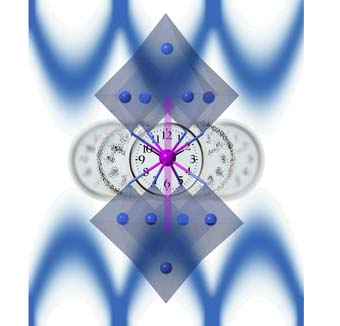
An international team of physicians and chemists, among them scientists of the Institute for Molecular Science of the Universitat de València (ICMol), have developed a new strategy in order to improve the performance of the powerful quantum bits -also called qubits-, that consists on making these nanomagnets invisible to the magnetic field. The discovery, published on the Nature magazine, means another step towards one of the Holy Grails of the modern applied physics: the construction of quantum computers.
An international team of physicians and chemists, among them scientists of the Institute for Molecular Science of the Universitat de València (ICMol), have developed a new strategy in order to improve the performance of the powerful quantum bits -also called qubits-, that consists on making these nanomagnets invisible to the magnetic field. The discovery, published on the Nature magazine, means another step towards one of the Holy Grails of the modern applied physics: the construction of quantum computers.
In comparison to the current computers and devices, that are based on transitions to process information ‘bits’ in the form of binary 0 and 1, quantum computers predict an exponential growth of the velocity when performing computing tasks. The high power of qubits -the quantum analogue of the bit in computer science- could leave behind current machines and revolutionize fields like computing chemistry or cryptography, so fundamental for the communications security.
These advances seem possible in the wold of atoms and subatomic particles, where the physical laws that govern the behaviour of these quantum objects are very different from the ones of the ‘classic’ world we live in. However, these quantum states are very fragile and sensitive to the environment they are immersed in, and therefore the development of the very advanced devices that quantum mechanics predict turns out to be too much complicated to achieve.
The main problem that quantum computing based on magnetic qubits comes up against is that these have to communicate with each other in a too loud environment, until now hard to reduce, which impedes quantum information from transportating in an efficient way. This is to say, the interaction between qubits -even when it is possible in theory in the quantum world- it is presented full of magnetic noise when working in a real environment, interfering this way in the calculation.
The finding presented in the article consists on designing magnetic molecules that become invisible when interacting with a magnetic field. In a way, these magnetic molecular qubits are analogue to the metamaterials -materials that are invisible to the light-, which allows them to communicate with each other without being affected by the magnetic noise generated both by the environment and for the magnetic interactions between them when getting closer. The molecules in question are based on Holmium ions encapsulated by a molecular oxide, the polyoxometalate.
In order to achieve this invisibility, scientists have made the most of a similar process that is used in the so called Atomic Clocks, high accuracy devices to measure time that take advantage of the fact that resonance frequency among two atomic states remains constant and insensitive to extern disturbances, such as the ones produced by a magnetic field. Therefore, scientists have called this operations ‘atomic clock transitions’.
It is just another step forward, but an essential step to keep on moving forward in the design of stronger magnetic qubits that allow, in the short term, to improve the communication among them and to process the quantum information in a more efficient way; and in the long term, to construct quantum computers based on these magnetic molecules.
This work is the result of a collaboration established between the ICMol (directed by Eugenio Coronado) and the National High Magnetic Field Laboratory of Tallahassee (directed by Steve Hill). The team of Valencia that has developed this work has been the one formed by Yan Duan -a thesis student that has obtained the magnetic molecules-, Alejandro Gaita and Eugenio Coronado. These last two have conceived the research and hav written the article that represents one of the most important landmarks of the ERC grants given to both researchers by the European Commission.
Article:
‘Enhancing coherence in molecular spin qubits via atomic clock transitions’
Muhandis Shiddiq(1), Dorsa Komijani(1), Yan Duan(2), Alejandro Gaita-Ariño(2), Eugenio Coronado(2) & Stephen Hill(1)
Nature, doi:10.1038/nature16984
Last update: 17 de march de 2016 11:06.
News release



















